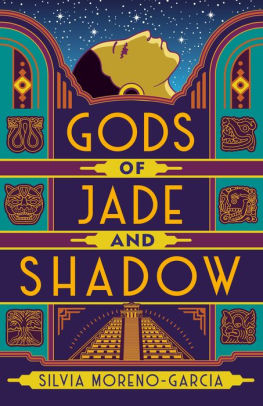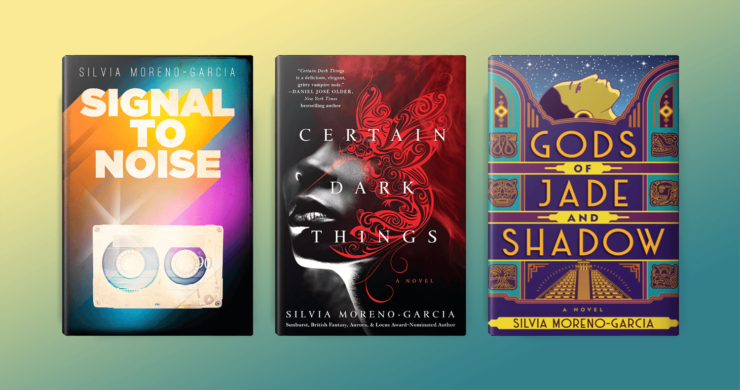When I was a little girl, my father would tell me the same bedtime story every night.
It was a story about a mother coyote who was looking for her lost son. She traveled from town to town looking for him, describing him in the way loving mothers often do: He was strong and healthy with beautiful, shining fur. No one had seen him. They had only seen a mangy, emaciated animal, dead on the side of the road. Anguished, the mother cried out that that was her son. Based on a Mexican indigenous fable, it was a cautionary tale about deception and truth, and as an impressionable eight-year-old, it stuck with me.
There are stories whose words embed themselves in your soul. They stay there, long after the last page has been turned, and hold the warmth of an old friend’s embrace.
The first time I read a Silvia Moreno-Garcia book, the words didn’t just hug me, they wrapped themselves around my beating heart and squeezed. They demanded my attention and feelings—all of them.
One of the first things I noticed about her work is how Moreno-Garcia’s words are tinged with a distinctly Mexican sense of melancholy. They tell tales of the fantastic and transcendent, of the bittersweetness that infuses each breath, each moment of humanity. Her monsters are tormented and romantic, filled with both yearning and angst. When I read about them, I am reminded of the little coyote, of a bedtime story filled with danger, love, sadness, and just a hint of uncertainty.
The more you read of her work, the more it becomes apparent that Moreno-Garcia’s characters are structured by and for the female gaze. Their journeys feel limitless because they are given complete agency to choose any and all paths. Wrong choices still feel right because as readers, we know they were made out of the character’s own free will, in spite of the potential consequences. Female characters are not plot devices tucked in snugly to fit a predetermined narrative—these women are creators of their own destinies, blazing their own paths. In Certain Dark Things we follow an Aztec vampire called Atl. Atl is the protagonist of the story, but she is not always heroic. She is morally grey and we see her unabashedly dip in between those various shades of grey throughout the novel. This is a unifying quality that connects many of Moreno-Garcia’s female characters. They are never entirely good or bad, wrong or right: they are just brazenly themselves. By allowing them the space to be layered, Moreno-Garcia challenges the reader’s own preconceived notions of the genre, and about the characters themselves.
Buy the Book


Gods of Jade and Shadow
Even in her most recent novel, the folklore-inspired adventure Gods of Jade and Shadow, Moreno-Garcia doesn’t allow generic conventions to get in the way of the glorious complexity of her characters. In the novel, Casiopea Tun embarks on a time-sensitive cross-country road trip with a Mayan God of Death, Hun Kame. The pair inevitably develop feelings for one another over the course of this journey, but instead of boxing Casiopea into a specific archetype, Moreno-Garcia allows her to run the gamut of realistic emotions and reactions: she is scared and brave, naive and quick-witted. She is both the damsel and savior all at once. To the reader, she feels nuanced and deeply real, and when Casiopea must ultimately make her final choice, it burns—but in the best way.
In Prime Meridian, the main character, Amelia, is a lonely dreamer living in near-future Mexico City who fantasizes about leaving Earth. Her aspirations are often tinged by a mist of nihilism, at the same time. She is struggling to get by, and longs for a future on Mars while feeling ambivalent towards her reality on Earth. She purposely makes mistakes that carry consequences…yet she’s comforted by the knowledge that they are hers to make. In this quiet novella, Amelia holds the gravity of both planets inside her mind. She’s serious and filled with longing in a uniquely realistic way, and moves through the world with a relatable sadness.
Mexico is front and center as the setting for Moreno-Garcia’s stories. Latinx and Mexican readers will recognize pieces of themselves throughout the text, whether it be in the form of a ham torta, in the visual-heavy descriptions of the surroundings, or in throwback tunes like those featured in Signal to Noise. Places like Mexico City are transformed into labyrinths of mystery and desolation. Baja California’s desert becomes a site of resurrection and a setting for showdowns. As a reader, it is so satisfying to see your roots and your experiences featured so prominently in a genre that doesn’t necessarily highlight stories like these often.
At the same time, Moreno-Garcia uses SFF stories to scrutinize Mexican society. In a recent Twitter thread, she explained that she made most of her main characters dark-skinned because of the colorism that often runs unchecked in Mexico. “The women in several of my books are dark and beautiful because my mother was told she was ugly due to her dark skin and Indigenous heritage. It’s a gift to my mother each time she can picture herself as the hero.” Moreno-Garcia further layers this critique throughout her fiction by also calling out the classism and discrimination that many in Mexico experience due to their darker skin color, and contrasting these experiences with the privileges of having light skin. While many of her stories take place in fantastical settings, her heroes also deal with real life problems, and she tackles these issues thoughtfully and deliberately, putting power back into the hands of the marginalized. There’s a sense of duality embedded at almost every level in her work: Her worlds are never just about a singular issue. There is an intersectionality woven into both the micro and macro elements of her plots. This masterful complexity and sustained structural push-and-pull makes for storytelling that is otherworldly and fantastically paced.
No matter where you start reading her work—with Signal to Noise, The Beautiful Ones, Certain Dark Things, Gods of Jade and Shadow, or with her shorter fiction—Moreno-Garcia’s stories are multifaceted, surprising, and constantly challenge the reader to redefine their own preconceived notions of what they think speculative fiction is and can be. She is a trailblazer in the genre, always finding new ways of exploring familiar elements and conventions, and I’m so excited to see what other stories she has to tell us in the years to come.
In 2020, we’ll have at least two new Silvia Moreno-Garcia books to enjoy. Untamed Shore, Moreno-Garcia’s first adult crime noir, is set in 1970s Baja California, and involves a girl named Viridiana, a Bonnie and Clyde-esque couple, and murder… Unlike her previous works, this book is grounded in realism with no supernatural elements, but fans can look forward to being spellbound by the way she creates tension through her complex and intricate character development in this dark coming-of-age tale of a girl learning to put herself first. And in June, the suspenseful fantasy Mexican Gothic will be a triumphant return to the realm of genre fiction. It begins with a young woman in 1950s Mexico summoned to an isolated mansion, described as a “reimagining of the classic gothic suspense novel.” Knowing Moreno-Garcia’s writing style, both books will likely be a fresh take on stories that aren’t quite what you expect them to be (and of course, they may well break our hearts by the end…)
Andrea Gomez is a Mexican-American freelance writer and book reviewer from Southern California. She has a B.A. in Literary Journalism and Film and Media Studies from UC Irvine. When she isn’t reading, she likes to watch binge watch angsty TV shows. Her words can be found on The Young Folks and across the internet at linktr.ee/pagecactus.










